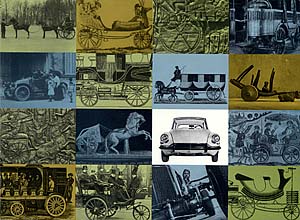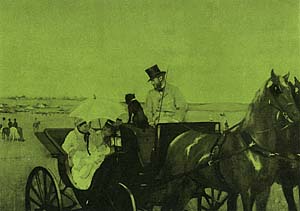|
||||||||||||||||||||||
 |
A SHORT HISTORY OF SUSPENSIONPart Four |
|
At present there are still two types of unsprung vehicles: tumbrels and farm carts -- wooden frames placed on an axle with two large wheels. With such a vehicle, the least jolt is transmitted integrally to the body. If the horse drawing the cart walks, as is normally the case, there are no other disadvantages than the sometimes unpleasant bumps. But if it goes fast or runs wild, the frequency of the bumps will increase along with their intensity, as the vertical force of the jolts is in direct proportion to the square of the speed of the vehicle. The expedition is liable to finish badly, with the driver and load ejected. How can this be
avoided? |
|

Above Degas: the carriage at the races Below Harland automobile car. English print.
XIXth century. |

Brazilian landowner returning to town |
 |
The answer is to prevent the jolts due to the uneven ground surface from being transmitted in their entirety to the passengers. Although several thousand years were necessary to find the answer, it seems clear enough. What do people
do in order to sleep comfortably ? They place a mattress between
themselves and the ground or rather between themselves and the bedstead
nowadays. The softer the springs of the mattress, the more comfortable
the sleeper will be. |
|
Let us transpose this example: if the sleeper represents the car (the suspended masses) and the bedstead the wheels (non-suspended masses), it is simply necessary to place an elastic element i.e. a spring, between the two. The spring must be soft enough to allow for the most violent jolts. This condition introduces the first theorem of suspension: the more elastic the spring, the less the suspended masses will be shaken. Thus, the trend of spring design has been to make them softer and softer and more and more flexible. |
|
|
This led to the discovery of air springing, which is far more elastic than a metal spring, as can be seen from its current applications: car tyres (much softer than the first metal wheels or the solid rubber tyres) and footballs. However, the question is rather more complicated. Though it is true that the comfort of the mattress increases with the flexibility of its springs, there is a limit after which this is no longer true, as the springs will collapse under the weight if they are too soft. Following his weight and tastes, each individual has to choose the mattress that suits him. The ideal mattress for a weight of 2-300 lbs will be far less ideal if it has to carry a load of 100 lbs. |
 |
|
|
|
|
Lotz road locomotive. French print. 19th century |
|
|
© 2000
Julian Marsh
|
|


